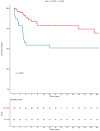Solitary Extramedullary Plasmacytoma of the Larynx and Secondary Laryngeal Involvement in Plasma Cell Myeloma: Single-Centre Retrospective Analysis and Systematic Literature Review
- PMID: 35956004
- PMCID: PMC9369432
- DOI: 10.3390/jcm11154390
Solitary Extramedullary Plasmacytoma of the Larynx and Secondary Laryngeal Involvement in Plasma Cell Myeloma: Single-Centre Retrospective Analysis and Systematic Literature Review
Abstract
The involvement of the larynx in plasma cell myeloma (PCM) may manifest as solitary extramedullary plasmacytoma of the larynx (sEMP-L) or as infiltration of the larynx during newly diagnosed or relapsed systemic disease with bone marrow involvement (plasma cell myeloma with laryngeal involvement, PCM-L). To increase knowledge about these rare conditions, we performed a retrospective analysis along with a comprehensive literature review of cases of sEMP-L or PCM-L. Six patients (two sEMP-L and four PCM-L) were identified in our tertiary laryngological centre from 2009 to 2021, constituting 0.88% of all malignant laryngeal tumours. The literature search yielded 187 cases, including 152 sEMP-L and 35 sPCM-L. A comparison of baseline characteristics between sEMP-L and PCM-L performed in the combined cohort of cases from literature review and retrospective analysis revealed that patients with sEMP-L were younger (56 vs. 64 years, p ≤ 0.001) and presented less commonly with thyroid or cricoid cartilage involvement (2.2% vs. 30.8%, p ≤ 0.001). The prognosis of sEMP-L was better than PCM-L (overall survival 86% vs. 55% at 5 years, p = 0.002). Analysis of potential factors that could influence progression-free survival (PFS) in the group of sEMP-L revealed that male sex and cartilage involvement negatively affected PFS in univariate analyses, while only cartilage involvement retained statistical significance in multivariate analysis (HR = 19.94, p = 0.024). In conclusion, PCM with laryngeal involvement is sporadic. Secondary involvement of the larynx during PCM might be more common than sEMP-L and is associated with worse survival. The involvement of cartilage adversely influences the outcome of sEMP-L.
Keywords: extramedullary plasmacytoma; larynx; multiple myeloma; plasma cell myeloma.
Conflict of interest statement
The authors declare no conflict of interest.
Figures





References
-
- Swerdlow S.H., Campo E., Pileri S.A., Harris N.L., Stein H., Siebert R., Advani R., Ghielmini M., Salles G.A., Zelenetz A.D., et al. The 2016 revision of the World Health Organization classification of lymphoid neoplasms. Blood. 2016;127:2375–2390. doi: 10.1182/blood-2016-01-643569. - DOI - PMC - PubMed
-
- McKenna R.W., Kyle R.A., Kuehl W.M., Grogan T.M., Harris N.L., Coupland R.W. Plasma cell neoplasms. In: Swerdlow S.H., Campo E., Lee Harris N., Jaffe E.S., Pileri S.A., Stein H., Thiele J., Vardiman J.W., editors. WHO Classification of Tumours of Haematopoietic and Lymphoid Tissues. 4th ed. International Agency for Research on Cancer (IARC); Lyon, France: 2008. pp. 198–213.
LinkOut - more resources
Full Text Sources

